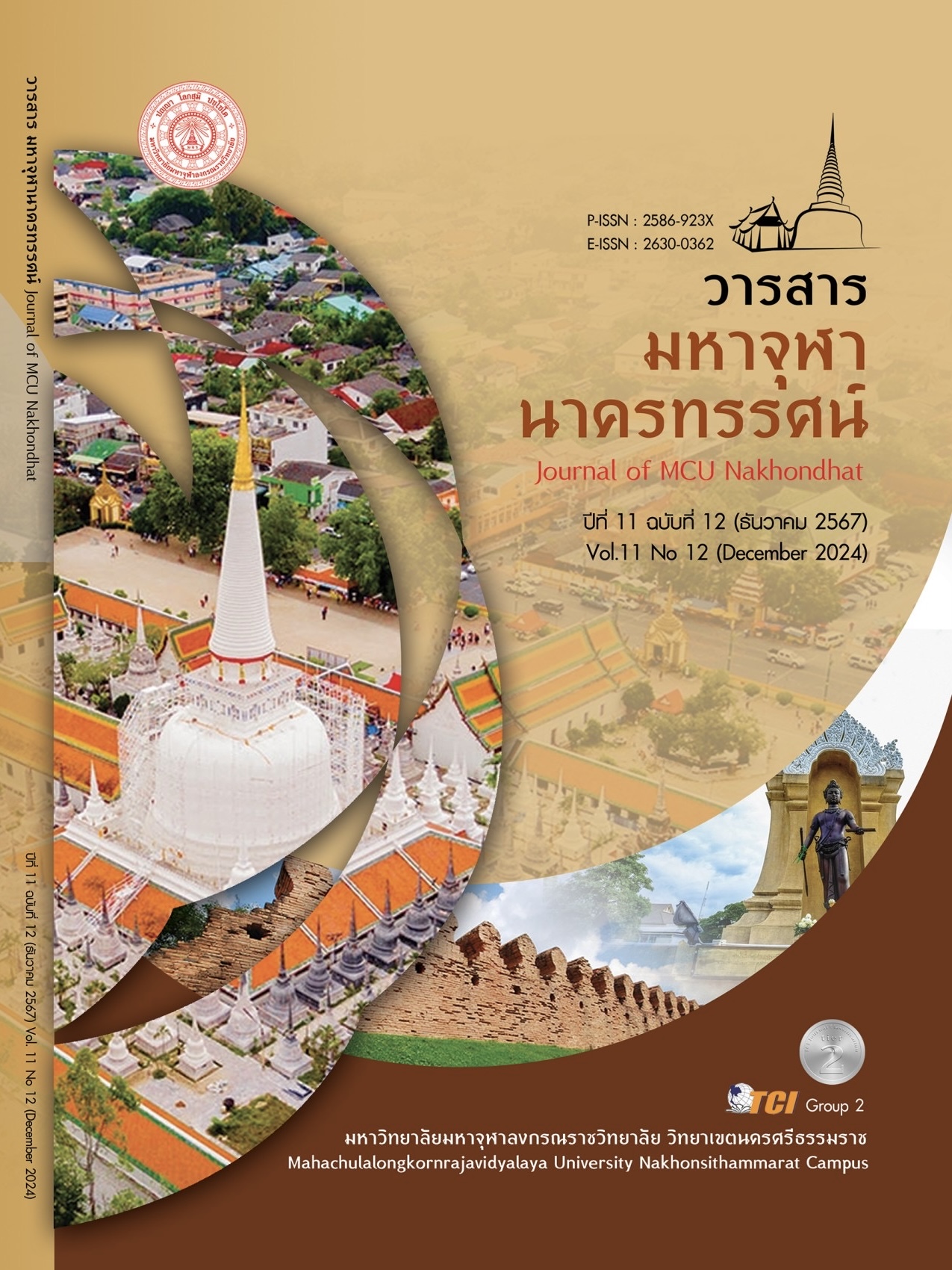การพัฒนาผลิตภัณฑ์การแปรรูปขยะจากเปลือกมะพร้าวทางการเกษตรที่หลากหลายของเกษตรกรชุมชนบ้านแพ้ว จังหวัดสมุทรสาคร
Main Article Content
บทคัดย่อ
การวิจัยนี้มีวัตถุประสงค์เพื่อ 1) พัฒนาผลิตภัณฑ์การแปรรูปทางการเกษตรที่หลากหลายของเกษตรกรชุมชนบ้านแพ้ว จังหวัดสมุทรสาคร และ 2) ศึกษาความพึงพอใจที่มีต่อพัฒนาผลิตภัณฑ์การแปรรูปทางการเกษตรที่หลากหลายของเกษตรกรชุมชนบ้านแพ้ว จังหวัดสมุทรสาคร โดยใช้รูปแบบการวิจัยแบบผสมผสาน ประชากร ได้แก่ เกษตรกรสวนมะพร้าวน้ำหอมที่ลงทะเบียนเป็นอาสาสมัครกลุ่มชุมชนบ้านแพ้ว จำนวน 50 คน เครื่องมือวิจัย ได้แก่ ผลิตภัณฑ์การแปรรูปทางการเกษตร และแบบสอบถามประมาณค่า 5 ระดับ มีความเชื่อมั่นอยู่ที่ระดับ 0.96 การวิเคราะห์ข้อมูลโดยใช้เปอร์เซ็นต์ ค่าเฉลี่ย ส่วนเบี่ยงเบนมาตรฐาน และการวิเคราะห์เนื้อหา ผลการวิจัยพบว่า ผลการวิเคราะห์ความพึงพอใจที่มีต่อความพึงพอใจที่มีต่อพัฒนาผลิตภัณฑ์การแปรรูปทางการเกษตรที่หลากหลายของเกษตรกรชุมชนบ้านแพ้ว จังหวัดสมุทรสาคร ทั้ง 4 ด้าน พบว่า อยู่ในระดับมากที่สุด ( = 4.94,
= 0.15) พิจารณาผลการวิจัยรายด้านตั้งแต่ค่าเฉลี่ยสูงสุดถึงต่ำสุด ดังนี้ ค่าเฉลี่ยสูงสุด คือ ผลิตภัณฑ์เฟอร์นิเจอร์และของใช้จากแผ่นอัดจากเปลือกมะพร้าวน้ำหอมเหลือทิ้ง (
= 4.95,
= 0.17) รองลงมา คือ ผลิตภัณฑ์ดินผสมพร้อมปลูกจากเปลือกมะพร้าวน้ำหอมเหลือทิ้งบรรจุถุง (
= 4.94,
= 0.13) ผลิตภัณฑ์ผ้ามัดย้อมสีสกัดจากเปลือกมะพร้าว และผลิตภัณฑ์ถ่านเชื้อเพลิงเปลือกมะพร้าวจากเตาเผาถ่านไร้ควันบรรจุถุงมีค่าเฉลี่ยต่ำสุด (
= 4.93,
= 0.14 และ
= 4.93,
= 0.15) โดยมีผลการศึกษาในเชิงแนวทางการพัฒนาต่อยอด 1) ผลิตภัณฑ์ดินผสมพร้อมปลูกจากเปลือกมะพร้าวน้ำหอมเหลือทิ้งบรรจุถุง 2) ผลิตภัณฑ์เฟอร์นิเจอร์และของใช้จากแผ่นอัดจากเปลือกมะพร้าวน้ำหอมเหลือทิ้ง 3) ผลิตภัณฑ์ถ่านเชื้อเพลิงเปลือกมะพร้าวจากเตาเผาถ่านไร้ควันบรรจุถุง และ 4) ผลิตภัณฑ์ผ้ามัดย้อมสีสกัดจากเปลือกมะพร้าว
Article Details

อนุญาตภายใต้เงื่อนไข Creative Commons Attribution-NonCommercial-NoDerivatives 4.0 International License.
เอกสารอ้างอิง
กรมวิชาการเกษตร. (2551). คู่มือวิธีวิเคราะห์ปุ๋ยอินทรีย์. กรุงเทพมหานคร: ควิกปริ๊นท์ออฟ เซ็ท.
กรมวิชาการเกษตร. (2558ก). ปุ๋ยอินทรีย์การผลิต การ ใช้มาตรฐานและคุณภาพ. กรุงเทพมหานคร: กระทรวงเกษตรและสหกรณ์.
กรมวิชาการเกษตร. (2558ข). ประกาศกรมวิชาการเกษตร: เรื่องมาตรฐานปุ๋ยอินทรีย์ พ.ศ. 2558. เรียกใช้เมื่อ 2567 เมษายน 6 จาก https://www.doa.go.th/ard/wp-content/uploads/2019/11/FEDOA11.pdf
คณาจารย์ภาควิชาปฐพีศาสตร์. (2558). ปฐพีเบื้องต้น. กรุงเทพมหานคร: สำนักพิมพ์มหาวิทยาลัยเกษตรศาสตร์.
จรัส สุวรรณมาลา. (2558). การพัฒนาเศรษฐกิจท้องถิ่นบนเส้นทางกระจายอำนาจของไทย. กรุงเทพมหานคร: สถาบันพระปกเกล้า.
ณพัฐอร บัวฉุน. (2561). ฤทธิ์ต้านอนุมูลอิสระและสารประกอบฟีนอลิกของเมล็ดแหละเนื้อมะม่วงไม่รู้โห่. วารสารวิจัยและพัฒนา วไลอลงกรณ์ ในพระบรมราชูปถัมภ์ สาขาวิทยาศาสตร์และเทคโนโลยีม, 13(2), 52-63.
วันปิติ ธรรมศรี และคณะ. (2564). การนำวัสดุเหลือใช้จากกากมะพร้าวมาใช้ในการผลิตคอนกรีตบล็อก. วารสารวิชาการ มหาวิทยาลัยราชภัฏอุตรดิตถ์, 17(1), 117-129.
สังเวย เสวกวิหารี และอุดมเดชา พลเยี่ยม. (2563). การผลิตเชื้อเพลิงอัดแท่งจากเปลือกมะพร้าวอ่อน. กรุงเทพมหานคร: มหาวิทยาลัยเทคโนโลยีราชมงคลพระนคร.
สำนักงานเกษตรและสหกรณ์ จังหวัดปัตตานี. (2561). 10 สูตร “ดินปลูก” ครอบจักรวาล. เรียกใช้เมื่อ 3 พฤศจิกายน 2561 จาก https://www.opsmoac.go.th/pattani-article_prov-preview402891791804
สิงห์ อินทรชูโต. (2564). แนวคิดเมืองคาร์บอนต่ำ สุขอาศัยอย่างยั่งยืน. เรียกใช้เมื่อ 6 เมษายน 2567 จาก https://www.wearecp.com/mqdc-2206202
Likert. (1970). New Partterns of Management. New York: McGraw-Hill.


